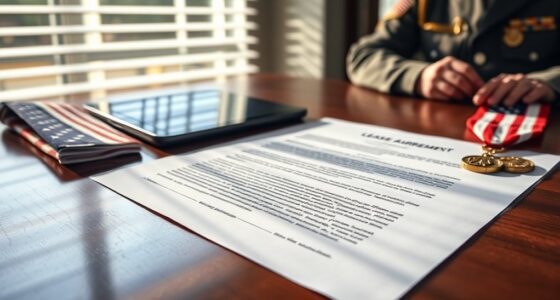After bankruptcy, you can rebuild your credit and secure leases by demonstrating responsible financial habits such as paying bills on time and reducing debt. Consider starting with smaller lease agreements and offering larger security deposits to lower perceived risk. Working with leasing companies that specialize in credit-blemished applicants and having a co-signer can also help. Keep up responsible behavior over time, and you’ll improve your chances—more strategies to help you succeed are just a step further.
Key Takeaways
- Rebuild credit by making timely payments and reducing debts to improve leasing eligibility after bankruptcy.
- Provide proof of income and references to demonstrate financial stability during lease applications.
- Consider smaller leases or higher security deposits to mitigate risk and increase approval chances.
- Use co-signers with good credit or work with leasing companies specializing in credit-blemished applicants.
- Maintain responsible financial habits post-bankruptcy to gradually restore leasing opportunities and creditworthiness.

Have you wondered what happens to your leasing options after filing for bankruptcy? It’s a common concern, especially if you rely on leasing to get a vehicle or equipment. While bankruptcy can feel like a setback, it doesn’t mean you’re permanently shut out of leasing opportunities. In fact, you can begin rebuilding your credit and work toward qualifying for leases again, but it requires some strategic planning.
One of the first steps is understanding that leasing companies will scrutinize your credit report carefully. Your credit rebuilding efforts will play a vital role in lease qualification. After bankruptcy, your credit score might take a hit, but it isn’t impossible to improve it. Paying bills on time, reducing outstanding debt, and avoiding new negative marks can help boost your credit profile over time. Some lenders or leasing companies are willing to work with applicants who demonstrate responsible financial behavior post-bankruptcy, especially if you have a steady income and a plan to rebuild credit.
When applying for leases, you’ll find that many lessors will look beyond your credit score. They may request additional documentation to verify your ability to make payments, such as proof of income or references. Being transparent about your financial situation and showing a history of responsible management can enhance your chances of lease approval. It’s also helpful to start with smaller lease agreements or those with more flexible qualification criteria to build a leasing history again.
Another effective way to improve your lease qualification prospects is to consider a co-signer or a larger security deposit. A co-signer with good credit can reassure lessors that you’re a reliable borrower, increasing the likelihood of approval. Alternatively, offering a bigger security deposit can mitigate perceived risk for the leasing company, making it more likely they’ll approve your application despite a recent bankruptcy.
Keep in mind that some leasing companies specialize in working with individuals who have a credit blemish. They understand the challenges of rebuilding credit after bankruptcy and may offer lease options tailored to your situation. Over time, making consistent on-time payments on your lease will further help rebuild your credit profile, making future leasing easier. Additionally, reviewing anime movies or exploring other credit-building resources can provide helpful guidance during your recovery process.
Frequently Asked Questions
How Long Must I Wait After Bankruptcy Before Leasing Again?
You typically need to wait at least 1 to 2 years after bankruptcy before leasing again, though it varies by lender. During this time, credit counseling can help you rebuild your credit and improve your chances. Keep up with vehicle maintenance and avoid missed payments to strengthen your application. Being patient and demonstrating responsible financial habits will make leasing more accessible once the waiting period ends.
Can I Lease a Vehicle With a Recent Bankruptcy on My Record?
You can lease a vehicle with a recent bankruptcy on your record, but your options may be limited. Lenders will review your credit rebuilding progress and may require a larger down payment or higher interest rates. To improve your chances, focus on demonstrating responsible credit use and explore specialized leasing options for those with credit challenges. Patience and consistent financial habits will help you secure better leasing offers over time.
What Documents Are Required to Qualify for Leasing Post-Bankruptcy?
Imagine you want to lease a vehicle after bankruptcy; you’ll need to provide proof of income to show you can afford payments. Typically, you’ll also need a current credit report to assess your creditworthiness. For example, a borrower with steady employment and a positive credit report, despite recent bankruptcy, can improve approval chances. Prepare these documents: proof of income, recent credit report, and identification to streamline the leasing process.
Are There Special Leasing Options for Those With a Bankruptcy History?
You might find some special leasing options available if you have a bankruptcy history. These options often include programs tailored for those rebuilding credit, with more flexible terms or higher down payments. While not all lenders offer these, exploring dealerships or leasing companies that specialize in bankruptcy options can increase your chances. Keep in mind, demonstrating stability and improving your credit score will boost your eligibility for these special leasing programs.
How Does Leasing Affect My Credit Score Recovery?
Leasing can positively impact your credit score recovery if you make timely payments, showing lenders you’re responsible. The leasing impact on your credit score depends on how consistently you meet your lease obligations. Regular, on-time payments boost your credit history, helping rebuild trust with future lenders. Conversely, missed payments can harm your credit score. Overall, responsible leasing can be a helpful step in improving your credit profile.
Conclusion
Rebuilding your credit after bankruptcy is like planting seeds in a barren field—you’ll need patience, care, and time. Leasing can be your steering wheel, guiding you back onto the road of financial stability. With each responsible choice, you’re paving a smoother highway ahead. Remember, even the darkest night gives way to dawn; your credit journey may have hit a bump, but brighter days are just over the horizon. Keep moving forward—you’re crafting a fresh start.










